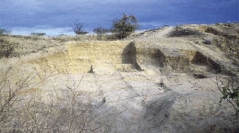

 Comptes Rendus Palevol
5 (1-2) - Pages 119-126
Comptes Rendus Palevol
5 (1-2) - Pages 119-126The oldest manufactured tools, dating back to 2.5 Myr in Gona, region of Hadar, in the Northeast of Ethiopia (Kada Gona, EG 10, EG 12, OG 6, OG 7), the slightly more recent ones of Omo 71 (2.3 Myr), of Fejej FJ-1 (2 Myr), also in Ethiopia, or the Lokalelei ones (2.3 Myr) in Kenya, bear evidence to the emergence of conceptual thinking and of the possibility for the first men to conceive a model. As man had become a meat consumer, his concern when making a tool was to obtain a sharp instrument intended to disarticulate the flesh of big herbivores or to cut meat. A tool conceived and then manufactured in the light of a project, not always immediate but sometimes remote in time, is part of the chaîne opératoire. In order to make the planned model, the craftsman collects rocks at a certain distance and chooses them according to their petrographic and morphologic nature. Once transported to the workplace, he knaps them, using well-mastered strategies of débitage governed by know-how, which imply transmitted instruction. The tools manufactured this way will be then transported to the place where they will be used, for instance around the carcass of a big herbivore in order top cut it. In inventing the manufactured tool, man introduced a new dimension to the History of the Universe and Life: culture.
Stone splitting, conceptual thought, outset of hominization